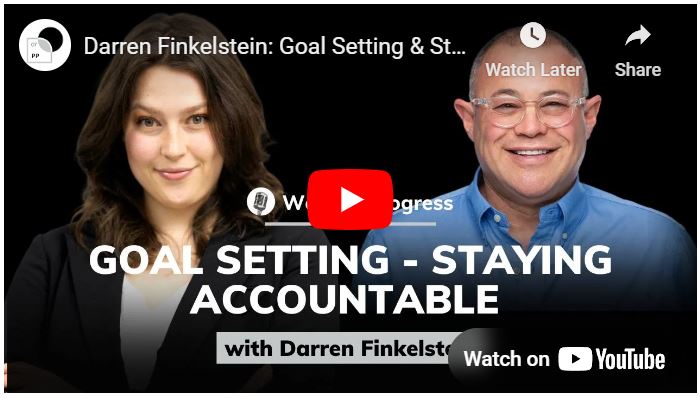Everyone takes in information differently. Some people learn best by seeing things laid out clearly. Others need to hear it. Some prefer to get hands-on, while a few need written words to really absorb something. When coaching people, it doesn’t make sense to take a one-size-fits-all approach. People bring different strengths, preferences, and habits into the room, and it’s the coach’s job to make sure each person actually understands and connects with what’s being shared.
Discover your Accountability Score and increase the probability of smashing your GOALS and Getting Sh!t Done!
Customising your coaching approach to align with an individual’s learning style can significantly impact the effectiveness of your message. When someone feels that the coaching is working with how they naturally think and learn, it has a bigger impact. It keeps them engaged, helps them implement what they’ve learned, and builds stronger accountability habits. That sort of shift can lead to notable growth within teams and across organisations.
Understanding Different Learning Styles
Before you can adjust how you coach someone, you’ve got to understand how they learn. There are four common learning styles you’re likely to come across: visual, auditory, kinaesthetic, and reading/writing. Each has its own style, and knowing that helps you shape what coaching methods will be most useful.
Here’s a quick breakdown:
– Visual learners: These people learn best by seeing. Diagrams, charts, graphics, videos and slide decks help them understand complex ideas. If they can picture the concept, they’ll usually remember it.
– Auditory learners: Words matter to them, especially spoken ones. They retain information better when they hear it explained. Conversations, voice notes and verbal summaries work well.
– Kinaesthetic learners: They like to try things for themselves. They process information best when they are building or engaging in physical activities. Role plays or even walking meetings can help.
– Reading/writing learners: These folks do better when they interact with text. They connect most with written coaching materials, like handouts, printed instructions, workbooks, or structured journaling.
Most people sit somewhere in the middle and have a mix, but they usually lean into one or two main preferences. Watching how someone responds during a session helps identify their style. If they’re constantly scanning visuals, they might be visual. If they keep asking questions out loud, they may lean auditory. Asking a couple of clear questions also works well to spot preferences early.
Tailoring Coaching Techniques to Learning Styles
Once you get to know someone’s learning style, you can start shaping how you present your coaching. That doesn’t mean reworking every session. It’s usually about making simple shifts so your message comes across better.
Here’s how that might work:
– For visual learners: Use diagrams, infographics, colour-coded notes, or flow charts. Keep tools like whiteboards on hand or shared visual boards online. Seeing ideas mapped out makes concepts stick.
– For auditory learners: Talk it out. Instead of handing out instructions, explain them. Repeat key points aloud and provide the option to record sessions so they can listen again if needed. Make room for verbal check-ins and back-and-forth discussions.
– For kinaesthetic learners: Have them involved. They’ll connect more deeply when they’re building, sketching, or trying out new processes. Role plays, mock tasks, and stand-up meetings can make your session more impactful.
– For reading/writing learners: Offer written handouts, session summaries, structured worksheets and journaling prompts. They’ll often retain information better when they’ve had the chance to write things down or read through material at their own pace.
The goal isn’t to label people into one category but to deliver coaching in a way that’s easy to engage with. Say you’re working with a founder who’s clearly kinaesthetic. They zone out during long slideshow presentations but engage fully when they’re drawing workflow diagrams or mapping customer journeys. Tailoring your session to that hands-on approach makes a difference.
Matching your delivery with how someone learns improves understanding. Sessions become smoother and more action-focused, and the person feels better supported. That’s the mindset where accountability can take hold.
Benefits of Adapting Coaching Methods
When coaching speaks directly to how someone learns, it connects faster and sticks for longer. People absorb the right info and know what to do next. It makes next steps clearer, the coaching more meaningful, and people more likely to follow through.
Adapting methods in this way has a bigger effect on how accountable people are. Understanding expectations leads to focus, confidence in decision-making, and fewer repeated explanations. That’s a win for both the coach and the coachee.
Some benefits include:
– Clarity around action items and practical steps
– Fewer miscommunications during or after the sessions
– Higher energy and more buy-in from the coachee
– Greater ownership of responsibilities
– Behaviour change that actually lasts
Coaches find the sessions run better too. The exchanges feel more natural, the feedback loops are clearer, and there’s more collaboration. For the person being coached, feeling understood at this level builds trust. This means that they are fully committed to achieving their own results rather than merely participating without purpose. With those foundations, long-term growth has a better shot.
How to Implement Varied Methods in Entrepreneurship Coaching Programs
Entrepreneurship coaching programs naturally bring together a wide range of learning preferences. The founders or team leaders you’re coaching often think in very different ways. Blending various teaching techniques is one of the best strategies to make sure your program gets results across the board.
Here’s a guide to start putting that in place:
1. Spot the learning style early
At the beginning of a session, ask quick, non-intrusive questions. For example:
– How do you usually like to unpick new ideas—do you like to talk things through, map them out, try them physically, or write them down?
– When someone explains something tricky, do you prefer to see, hear, do, or read it?
2. Pay attention to their behaviour
Watch what holds their attention. Do they respond more when you draw it out? Do questions come more naturally during dialogues? Insights come from reactions, not just answers.
3. Use mixed methods where possible
Especially to start with, try offering the same idea in a couple of different ways. Use a visual diagram, follow it up with a discussion, then add an exercise or reflection page. Over time, narrow it down to match their learning pattern.
4. Match coaching style to the action required
Sometimes, the issue isn’t motivation—it’s mismatch. A written checklist might not help someone who learns best physically. Instead, a kinaesthetic learner may need an activity or prototype. Adjusting the format makes action easier.
5. Blend formats in group coaching
When coaching entrepreneurs in group settings, you’ll be managing several learning styles at once. Plan activities that incorporate visuals, short talks, take-home reading, and simple tasks. It keeps everyone involved without losing pace.
Let’s say you’re running a session with three early-stage founders. One is highly visual, always sketching out thoughts. Another prefers to hear steps and repeat them aloud. The third individual is action-oriented and needs to test and adjust immediately. You could sketch out a customer process on the whiteboard, explain it aloud, then have them each run through a version in their preferred way. This approach respects their learning preferences and shows that the material is flexible and accessible.
Results improve when the coachee feels understood. There’s greater clarity from the beginning, and feedback becomes more relevant. Sessions lose the dreaded one-size-fits-all feeling and become more targeted, productive, and memorable.
Your Path to Personalised Coaching Success
Learning isn’t a straight line, especially in business. Different people take in and apply knowledge in different ways. Coaching that acknowledges and adapts to these differencestends to open more doors and lead to better outcomes.
When someone can absorb information through their natural style, they’re more confident, they contribute more, and they stick with their actions longer. That’s when meaningful change starts to show.
True coaching doesn’t just hand over knowledge. It works with that knowledge until action happens. By meeting someone where they are—and coaching in a way that makes sense to them— you create better consistency and outcomes they’ll take ownership of. It pays off both for the coach and the person being coached.
Discover the transformative power of our entrepreneurship coaching programs at ‘Tick Those Boxes’. Our tailored approach aligns with your unique learning style, ensuring that each session is engaging and effective. Partner with us to develop stronger habits, boost your accountability, and turn your ideas into impactful actions. Let’s pave the way for your business success together.


